
views
- To clean a stainless steel sink, sprinkle ½ cup (136 g) of baking soda and scrub with a scrubbing brush, warm water, and dish soap.
- For a porcelain sink, cover the surface with paper towels and saturate them with hydrogen peroxide. Rinse the sink with water and buff with a microfiber cloth.
- To clean the drain, pour a mixture of ½ cup (136 g) baking soda and 1 cup (240 mL) warm water, then pour 1⁄2 cup (120 mL) of vinegar and let it sit for 10 to 15 minutes.
Cleaning a Stainless Steel Sink

Clean any dirty dishes and remove leftover food from your sink. Remove your sponge holder, drain stopper, scrub brush, and anything else you keep on the edge of your sink. Use gentle soap, soft cloth, and warm water to clean the faucet, drain, and outer rim. Acidic foods, bleach, and abrasive scrubbers can alter a stainless-steel sink's finish. Try to avoid letting acidic foods sit in the sink for a long period and avoid bleach-based sprays.

Sprinkle baking soda and scrub with warm water and soap. Sprinkle ½ cup (136 g) of baking soda inside the sink. Add warm water and a drop of dish soap to a sponge or scrubbing brush. Scrub along the grain, working from the top of the sink down to the bottom. Keep adding soap and water as needed until the sink is spot-free. Add 1 teaspoon (4.9 mL) of lemon juice to your sponge or scrubbing brush to help get out particularly tough stains and eliminate odors. Use a toothbrush, dish soap, and hot water to get all the cracks between the sink and the countertop. Try to avoid using hot water—it could blemish the stainless steel finish.
Rinse with water and use a microfiber cloth to buff it out. Polish the sides and bottom of the sink to make sure it’s shiny and clean. House cleaning professional Raymond Chiu also recommends “adding a few drops of baby oil to a microfiber cloth and gently wiping the stainless steel to add a nice sheen.” Stainless steel is notorious for revealing water spots, so drying and buffing the area can help remove any before they stick. If you notice any spots you missed during the cleaning process, spray some vinegar on them, rinse with clean water, and buff the area with a microfiber cloth.
Cleaning a Porcelain Sink
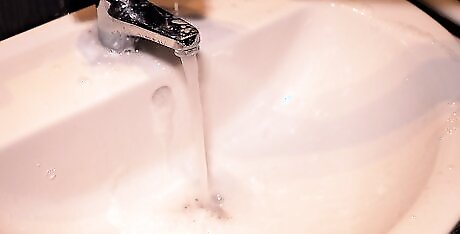
Wash down the surface with a gentle soap and warm water. Remove any objects around your sink and use an extendable faucet or a damp cloth dipped in warm soapy water to wash away food particles and other debris.
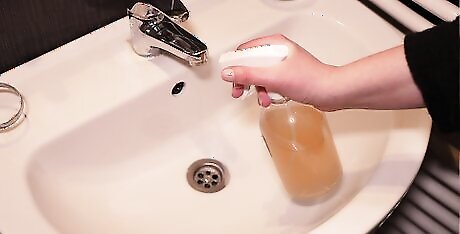
Cover the sink with paper towels and spray hydrogen peroxide. Let the solution sit in the sink for 30 minutes to an hour. Rinse the sink completely with clean warm water. Harsh scrubbing can damage porcelain, so try to use solutions like hydrogen peroxide to clean first.

Scrub rust and metal stains with lemon juice and table salt. Cover the rusted area with salt and squeeze the juice of half a lemon over it. Gently scrub the stain with a clean cloth or sponge. If the stain doesn’t come up, repeat this step and let the mixture sit for an hour before scrubbing again. Alternatively, apply a thin coat of naval jelly to the area. Rinse the area as soon as you notice a change in the color of the stain.

Tackle deeper stains with a mild abrasive cleaner. If you have a stain that just won’t come out or you’d like an alternative to hydrogen peroxide, use a gentle abrasive cleaner that’s safe on porcelain. Read the instructions on the back of the product and use a non-abrasive sponge or cloth to clean your kitchen sink. One popular safe and effective cleaner is Bar Keeper’s Friend. Squirt the product directly onto the stain and scrub with a soft cloth. Use mild abrasive cleaners sparingly to reduce the chance of discoloring or scratching your porcelain sink.
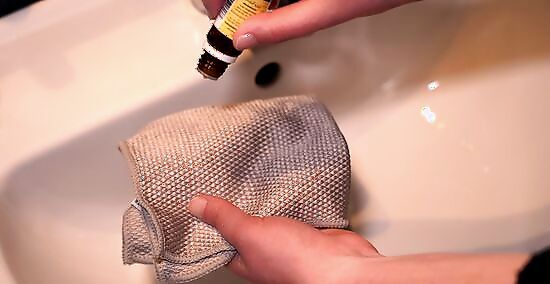
Rinse the sink with warm water and dry with a microfiber cloth. Use the cloth to buff out the sink until it’s shiny and smudge-free. Optionally, apply lemon essential oil to the microfiber cloth to repel soap scum and make the area smell fresh and clean.
Cleaning a Sink Faucet

Wash the handles and faucets with warm water and dish soap. Fill a bowl with warm water and a drop of dish soap. Dip a sponge or soft cloth in the solution and clean the faucet and handles. Use a toothbrush to get into any hard-to-reach areas. Rinse the area with cold water. If you notice limescale on the fixtures’ surface, soak a paper towel in white vinegar and place it over the area. Wait at least an hour, then wash the area with water and soap. To remove any grime around the base of the faucet, grab a piece of floss and saw it back and forth around the area. Wipe away any debris with a damp paper towel or cloth.

Use vinegar to remove hard water from the faucet head. Fill a plastic bag halfway with white distilled vinegar. Use a rubber band to tie the bag around the sink faucet so the head is completely submerged. Let the faucet soak for at least 2 hours, then remove the bag and scrub the head with a toothbrush, dish soap, and warm water. Add a few drops of lemon juice to the bag to help cut down on vinegar odors. To clean the kitchen sink sprayer, fill half a bowl with warm water and the other half with white vinegar. Dip a cloth into the mixture and wipe the hose and nozzle.
Thoroughly dry the fixtures with a microfiber cloth. Use the cloth to buff the faucet and handles until they’re shiny and free of water spots or stains. To prevent hard water stains in the future, try to wipe away water as soon as you’re done using the faucet.
How Often to Clean Your Sink
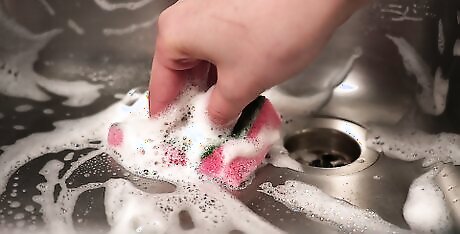
Rinse your sink daily and wash it weekly. Every time you rinse or wash dishes or pour anything down the drain, give your sink a thorough rinse to prevent food particles from hanging around or staining the surface. Also, clean your sink once a week with warm water and liquid soap.

Deep-clean your sink, faucets, and drain every month. Do a thorough clean at least once a month to remove grease, dirt, and soap scum from the sink, faucets, and drain.
Clean your garbage disposal once a week and sanitize it monthly. Prevent gunk from accumulating by cleaning and running your garbage disposal at least every two weeks. Sanitize your disposal each month by pouring 1 tablespoon of bleach and 1 quart of water down the drain.
How to Keep Your Sink Clean
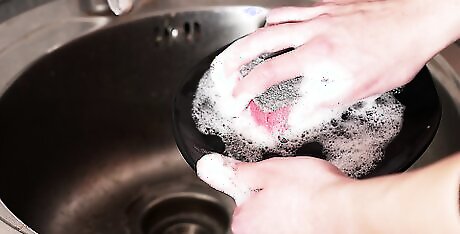
Clean your dishes every day. If you don't have a dishwasher, it can be easy to let the dishes go for a day or two (or longer). However, letting dirty dishes sit around can spread harmful bacteria. Clean your dishes, utensils, and surfaces with a sponge, dish soap, and hot water after each use. Some cookware can’t be submerged in water—if you’re not sure, check the manufacturer’s instructions before cleaning. Allow rags, dishcloths, and sponges to air dry or throw them in the washing machine. Replace sponges and rags frequently. House cleaning professional Raymond Chiu says to always “dispose of any leftover scraps in the garbage before placing [your dishes] in the sink.”

Use a disinfectant spray to sanitize your sink and countertops. Mix 1 cup (240 mL) distilled white vinegar, 1 cup (240 mL) of water, 3 drops of tea tree or lemon essential oil, and 3 drops of grapefruit essential oil in a bottle with a spray attachment. Shake the bottle and spray directly onto the surface as needed. White distilled vinegar can cut through grease and grime and contains acetic acid, which has antimicrobial properties. Tea tree, lemon, and grapefruit essential oils have antibacterial and antiseptic properties. Alternatively, purchase a natural disinfectant spray to sanitize your countertops and sinks after each use.


















Comments
0 comment